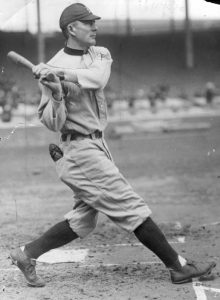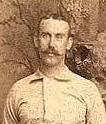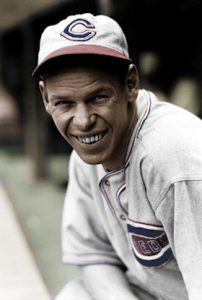Uni-Cycling, Bi-Cycling, Tri-Cycling…And Beyond?
March 9, 2024 by Frank Jackson · Leave a Comment
At some point during the 2024 season, you might hear your hometown play-by-play announcer say, “He’s only a (single/double/triple/homer) away from the cycle.” More than likely, it will be a triple, since that it is the least likely result of any plate appearance that results in a hit. If said hitter does complete the cycle, you can be assured it will be an item in the day’s sports news. And if it occurs as a natural cycle (single-double-triple-homer) that will be duly noted, as will a reverse natural cycle (homer-triple-double-single).
I’ve never been particularly impressed by someone hitting for the cycle, but when a hitter is just one hit away from a cycle, it does make for late-inning dramatics, no matter what the score. Of course, any time a batter gets four hits in a game he’s having a good day, but that isn’t necessarily a big deal. The ultimate rarity is a home-run cycle, in other words a solo shot, a two-run homer, a three-run homer, and a grand slam in the same game. That has never happened in major league baseball, and only twice in the minors, both times in the Texas League (Tyrone Horne of the Arkansas Travelers in 1998 and Chandler Redmond of the Springfield Cardinals in 2022).
So why is hitting for the cycle considered a big deal by baseball’s chattering classes? I mean, aside from the fact that if they don’t chatter about something, they would have to leave the broadcast booth and get a real job. Dead air has a deadening effect on a broadcasting career.
Some cycles, however, are rarer than others. When Luis Arraez completed a cycle for the Marlins on April 11, 2023, it was the first time in franchise history, which began in 1993. So once in three decades is newsworthy. I can’t argue with that.
Or how about Christian Yelich on August 29, 2018, who not only hit for the cycle against the Reds, he went 6 for 6, which is probably rarer than hitting for the cycle. So that is also newsworthy.
Then we have the highly unlikely occurrence of two cycles on the same day, which happened twice (Bobby Veach and George Burns on September 17, 1920; Adrian Beltre and Stephen Drew on September 1, 2008). Definitely headline news in the sports section.
The reason that cycles are rare is because triples are rare. Three-baggers were more plentiful in the Deadball era but in those days home runs were rare. Given the greater frequency of inside-the-park home runs before 1920, it is likely that a lot of the reported cycles included an ITPHR. Post-1920 the only cycle that included an ITPHR was achieved by Leon Culberson on July 3, 1943.
As rare as cycles are, some years they are more plentiful. In a sense, hitting for the cycle is a bit like rainfall. You have average years (say three or four per season) and then you have “wet” years, like 1933 and 2009 when eight players hit for the cycle each year. To balance out the wet years, you have “droughts,” such as 1951 through 1954 when only three players (Gus Bell 1951; Larry Doby 1952; and Don Mueller 1954) did it.
In scanning the list of players who have hit for the cycle, it soon becomes apparent that they are a bit like no-hit pitchers, meaning that even a mediocre hitter might achieve it once, but those who did it more than once were usually good players and many are in Cooperstown.
Among the obscure players who have hit for the cycle during the 19 th Century were Mox McQuery in 1885 , Chippy McGarr in 1886, Jumbo Davis (5’11” and 195 pounds, which would not qualify him for such a nickname today), Oyster Burns, and Farmer Weaver in 1890. Sure, there were others but I really thought those names were the most memorable…like something out of Ring Lardner or Damon Runyon.
That 1890 season was particularly rich as the cycle was achieved by four more hitters in addition to Davis, Burns, and Weaver. You might have heard of Roger Connor, who was the home run king before Babe Ruth came along. But have you heard of Mike Tiernan, Bill Van Dyke, or John Reilly? Probably not. Reilly, however, deserves special mention, and we’ll get back to him later.
Even in the modern era, there is no shortage of no-name players who hit for the cycle. Consider 1903, a fairly typical season when four cycles occurred. One was achieved by Fred Clarke, who led the league in slugging (.532) and OPS (.946) that year. You never saw Fred Clarke play but if you are a Seamhead, you have probably heard of him or maybe even seen a reproduction of an old cigarette card with his likeness. He played 21 seasons, had a career slash line of .312/.386/.429. If that isn’t impressive enough, he was a 19-year player-manager, mostly with the Pirates, and achieved a 1,602 – 1181 record. Along the way, Clarke won four pennants and one World Series (1909). He got the call to the Hall in 1945.
So Clarke’s resume has a long list of achievements. But what about Buck Freeman? Patsy Dougherty? And Bill Bradley? (No, not the NFL or NBA players so named.) They also achieved the cycle in 1903.
Beyond the Deadball era, those who achieved fleeting fame include Baby Doll Jacobson (1924), Ski Melillo (1929), Moose Solters (1934), Gee Walker (1937), and Hoot Evers (1950). Yeah, there were others but they had run-of-the-mill names so I left them out. Sue me. When indulging in name-dropping, stick with the colorful names.
Of course, the players who have hit for the cycle twice – let’s call it bi-cycling – form a more elite group. In 1883 the aforementioned John Reilly was the first to do so – and only one week separated his two feats (September 12 and 19). The others include Nolan Arenado, Ken Boyer, George Brett, Pete Browning, Cesar Cedeño, Mickey Cochrane, Joe Cronin, Michael Cuddyer, Joe DiMaggio, Bobby Doerr, Freddie Freeman, Jim Fregosi, Lou Gehrig, Carlos Gomez, Aaron Hill, Chuck Klein, John Olerud, Tip O’Neill, George Sisler, Chris Speier, Arky Vaughan, Bob Watson, Wally Westlake, Brad Wilkerson, and Frank White. Brock Holt is also among them, but with an asterisk, as he is the only player to hit for the cycle in the post-season (specifically, on October 8, 2018 vs. the Yankees).
So how many players have hit for the cycle three times in a career? Tri-cycling, as it were. If you said John Reilly (his third cycle was in 1890), go to the head of the class. The others are Bob Meusel, Babe Herman, Adrian Beltre, Trea Turner and Christian Yelich. TRICK QUESTION:Who is the seventh major leaguer to hit for the cycle three times? Bobby Rose, who played four seasons for the Angels (1989-1992), did it three times (May 2, 1995, April 29, 1997, and June 30, 1999) with the Yokohama BayStars.
So how many players have done it three times in a career, including twice in one season? This list includes just two names. Our old friend John Reilly is one of them. The other is Babe Herman, who did it twice for the Brooklyns in 1931 and once for the Cubs in 1933.
Herman might seem an unlikely player to rise to such an elite status, since baseball lore has consigned him to the “characters of the game” column. Without recounting his numerous misadventures on and off the field, let’s just say he is usually regarded as an eccentric at best or a nutter at worst. Unfortunately, this reputation tends to eclipse his outstanding 14-year career. Herman retired with 1,818 hits and a career slash line of .324/.383/.532.
His 1930 batting average of .393 was just five hits away from .400. (Unfortunately for Herman, Bill Terry won the 1930 National League batting championship with a .401 average.) So Herman is not as unlikely an achiever as he might appear to be at first glance.
Today there is the possibility that Herman and his colleagues in the tri-cycle club will soon be surpassed. It isn’t too much of a stretch to opine that one day Trea Turner (age 30) or Christian Yelich (age 32) might do it again and become the only man in baseball history to hit for the cycle four times. Let’s call it a quadricycle – which my dictionary defines as a foot-propelled four-wheeled vehicle – no, not like the Flintstones but propelled via pedals.
That fourth cycle could happen as early as opening day, March 28, 2024. Or it might never happen. Admittedly, as Turner and Yelich get older, the ability to leg out triples becomes more and more remote. Remote, however, does not mean impossible.
Consider the case of catcher Bengie Molina, one of the catching Molina brothers, which sounds like some sort of trapeze act. On July 16, 2010, Molina was plying his trade for the Rangers, who were facing the Red Sox. He singled in the 2 nd inning, doubled in the 4 th , and hit a grand slam in the 5 th . At that point, it would have been interesting to place a phone call to a sports book parlor in Vegas to ask the odds on Bengie Molina achieving a cycle before the game was over.
Perhaps the slowest player in baseball at the time (in his 13 th season, he had just 3 stolen bases and 5 triples among his 1,317 hits), he was 35 years old and in his final season. Bigfoot would have been more likely to hit a triple. But the game was being played at Fenway Park, where uncommon occurrences are commonplace.
When Molina came to the plate to lead off the 8 th inning, he hit a drive to center field that went off the glove of center fielder Eric Patterson and scooted to the deepest part (420 feet) of the ballpark. Molina hit not just a triple but a stand-up triple, which means a player of even average speed probably would have had an ITPHR. If you’re interested you can review the feat on YouTube. Notice that Molina’s running style could more accurately be described as jogging.
Also notice that his “official” weight (210 pounds on a 5’11” frame) in 2010 appears to be an underestimate. At any rate, the strain of his achievement took its toll and pinch-runner Joaquin Arias took over for him, eventually scoring on a sacrifice fly, which might not have been the case had Molina remained in the game.
I think Yelich or Turner hitting for the cycle a fourth time is more likely than Molina doing it once. Personally, I’m rooting for Yelich, but not because I have anything against Turner, who has had an admirable career to date. Yelich, however, has a chance at a particularly rare achievement. All three of his cycles have come against the Cincinnati Reds.
Now I’m not a math whiz so I wouldn’t know how to compute the odds against that trifecta. But I feel confident in saying that such odds, not to mention the odds against a superfecta, are indeed long – we’re talking Power Ball long. Yet any time the Brewers play the Reds, that possibility presents itself. (Mark your calendars: the Reds and Brewers square off for the first time on April 8 th ). If not in 2024, the possibility remains throughout Yelich’s career…unless he is traded to Cincinnati.
But why stop at four? Turner or Yelich could end up with five cycles – a quinticycle (there actually is such a thing), though nobody wants to be remembered as a fifth wheel.
Even so, it would be a feat worth chattering about.




